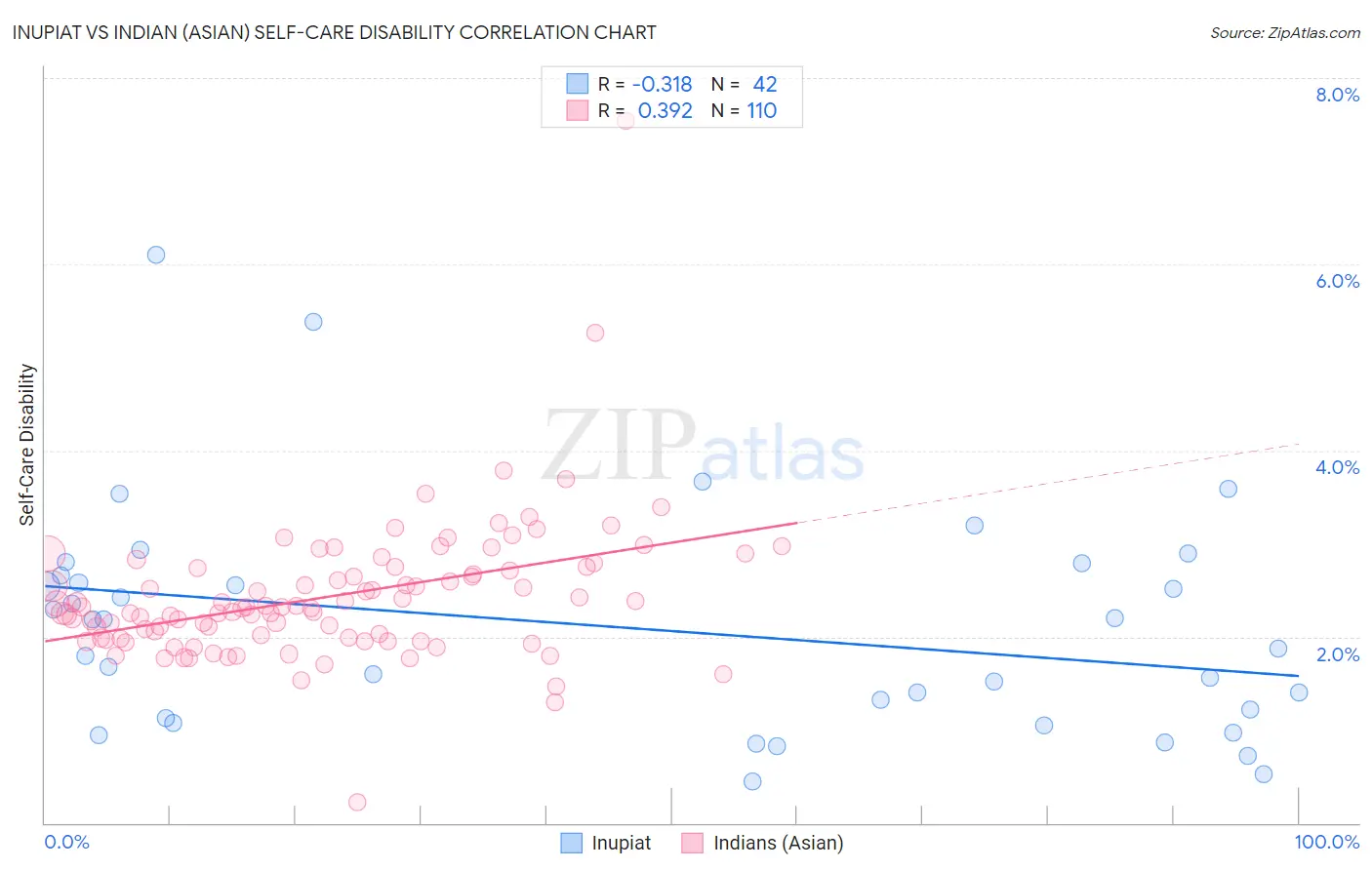Inupiat vs Indian (Asian) Self-Care Disability
COMPARE
Inupiat
Indian (Asian)
Self-Care Disability
Self-Care Disability Comparison
Inupiat
Indians (Asian)
2.2%
SELF-CARE DISABILITY
99.9/ 100
METRIC RATING
28th/ 347
METRIC RANK
2.3%
SELF-CARE DISABILITY
98.7/ 100
METRIC RATING
83rd/ 347
METRIC RANK
Inupiat vs Indian (Asian) Self-Care Disability Correlation Chart
The statistical analysis conducted on geographies consisting of 96,290,518 people shows a mild negative correlation between the proportion of Inupiat and percentage of population with self-care disability in the United States with a correlation coefficient (R) of -0.318 and weighted average of 2.2%. Similarly, the statistical analysis conducted on geographies consisting of 494,223,906 people shows a mild positive correlation between the proportion of Indians (Asian) and percentage of population with self-care disability in the United States with a correlation coefficient (R) of 0.392 and weighted average of 2.3%, a difference of 4.1%.

Self-Care Disability Correlation Summary
| Measurement | Inupiat | Indian (Asian) |
| Minimum | 0.45% | 0.22% |
| Maximum | 6.1% | 7.5% |
| Range | 5.7% | 7.3% |
| Mean | 2.1% | 2.4% |
| Median | 2.0% | 2.3% |
| Interquartile 25% (IQ1) | 1.1% | 2.0% |
| Interquartile 75% (IQ3) | 2.7% | 2.7% |
| Interquartile Range (IQR) | 1.5% | 0.76% |
| Standard Deviation (Sample) | 1.2% | 0.78% |
| Standard Deviation (Population) | 1.2% | 0.77% |
Similar Demographics by Self-Care Disability
Demographics Similar to Inupiat by Self-Care Disability
In terms of self-care disability, the demographic groups most similar to Inupiat are Immigrants from Zimbabwe (2.3%, a difference of 0.090%), Venezuelan (2.2%, a difference of 0.16%), Immigrants from Sri Lanka (2.2%, a difference of 0.17%), Turkish (2.2%, a difference of 0.24%), and Cypriot (2.2%, a difference of 0.35%).
| Demographics | Rating | Rank | Self-Care Disability |
| Bulgarians | 100.0 /100 | #21 | Exceptional 2.2% |
| Immigrants | Venezuela | 100.0 /100 | #22 | Exceptional 2.2% |
| Cambodians | 100.0 /100 | #23 | Exceptional 2.2% |
| Cypriots | 100.0 /100 | #24 | Exceptional 2.2% |
| Turks | 100.0 /100 | #25 | Exceptional 2.2% |
| Immigrants | Sri Lanka | 99.9 /100 | #26 | Exceptional 2.2% |
| Venezuelans | 99.9 /100 | #27 | Exceptional 2.2% |
| Inupiat | 99.9 /100 | #28 | Exceptional 2.2% |
| Immigrants | Zimbabwe | 99.9 /100 | #29 | Exceptional 2.3% |
| Paraguayans | 99.9 /100 | #30 | Exceptional 2.3% |
| Danes | 99.9 /100 | #31 | Exceptional 2.3% |
| Burmese | 99.9 /100 | #32 | Exceptional 2.3% |
| Immigrants | Korea | 99.9 /100 | #33 | Exceptional 2.3% |
| Immigrants | Turkey | 99.9 /100 | #34 | Exceptional 2.3% |
| Immigrants | Australia | 99.9 /100 | #35 | Exceptional 2.3% |
Demographics Similar to Indians (Asian) by Self-Care Disability
In terms of self-care disability, the demographic groups most similar to Indians (Asian) are Immigrants from Spain (2.3%, a difference of 0.040%), Ugandan (2.3%, a difference of 0.070%), Immigrants from Denmark (2.3%, a difference of 0.070%), Chilean (2.3%, a difference of 0.14%), and Immigrants from Middle Africa (2.3%, a difference of 0.33%).
| Demographics | Rating | Rank | Self-Care Disability |
| Immigrants | China | 99.1 /100 | #76 | Exceptional 2.3% |
| Immigrants | Middle Africa | 99.0 /100 | #77 | Exceptional 2.3% |
| Immigrants | Ireland | 99.0 /100 | #78 | Exceptional 2.3% |
| Immigrants | Kenya | 99.0 /100 | #79 | Exceptional 2.3% |
| Chileans | 98.8 /100 | #80 | Exceptional 2.3% |
| Ugandans | 98.8 /100 | #81 | Exceptional 2.3% |
| Immigrants | Denmark | 98.8 /100 | #82 | Exceptional 2.3% |
| Indians (Asian) | 98.7 /100 | #83 | Exceptional 2.3% |
| Immigrants | Spain | 98.7 /100 | #84 | Exceptional 2.3% |
| Estonians | 98.3 /100 | #85 | Exceptional 2.3% |
| Immigrants | Northern Africa | 98.2 /100 | #86 | Exceptional 2.3% |
| Sierra Leoneans | 98.0 /100 | #87 | Exceptional 2.4% |
| Lithuanians | 98.0 /100 | #88 | Exceptional 2.4% |
| Immigrants | Congo | 98.0 /100 | #89 | Exceptional 2.4% |
| Immigrants | Czechoslovakia | 97.7 /100 | #90 | Exceptional 2.4% |